How To Do Keyword Research For SEO: The Complete Training Guide
Daniel Trick
Feb 08, 2024
24 min read
Not sure how to do keyword research?
Don’t worry: we’ve got you covered.
In this comprehensive keyword research guide, you’ll learn how to do keyword research, how to analyze keywords, and how to apply them to your SEO strategy.
You’ll also learn how to find keywords your competitors aren’t using so you can beat them to the punch.
Check out our video guide below and read on to learn everything you need to know to kickstart your keyword research and take your online visibility to the next level.
How To Do Keyword Research Basics
Want us to do your keyword research for you? Check out our keyword research service.
The first step before we delve into how to do keyword research is to make sure that you understand the basics.
What Are Keywords?
Keywords are words and phrases that users type into search engines, like Google, to find the content they want. They may also be known as “SEO keywords.”
Keywords sit at the foundation of every search engine optimization strategy – the process your brand uses to rank higher in search results and attract more customers to your website.
Having the right amount of keywords on your pages tells search engines more about the content on your site, making it easier for them to match users to relevant content. That, in turn, helps increase relevant traffic and, hopefully, conversions.
What Is Keyword Research?
Keyword research is the process of finding popular search terms that people enter into search engines. It helps website owners optimize their content for higher visibility. To do keyword research, you can use various tools like Google Keyword Planner, SEMrush, or Ahrefs, which provide insights into the search volume and competition for specific keywords.
More specifically, it typically involves:
- Using digital keyword research tools to find, analyze, and compare thousands of candidate keywords.
- Narrowing down the most promising keywords or phrases.
- Using them throughout your Search Engine Optimization strategy.
You can think of keyword research as the blueprint for all of your digital marketing efforts and crucial to any SEO training. It should be the driving force behind every decision you make.
Ideally, your brand should do keyword research at the outset of a new SEO campaign. It doesn’t matter if you’re a startup company looking to connect with an audience for the first time or an established brand re-evaluating an existing approach; keyword research should come first.
Don’t worry if you’ve never done keyword research before. If there’s one thing we want to communicate in this keyword research guide, it is that it is never too late to start. Even if you have had a website for years, you can still use proper keyword targeting to promote your brand, make your marketing more effective, and, ultimately, reach your audience.
Why Is Keyword Research Important?
Keyword research is critical because it’s the only way to discover what terms your audience is typing into search engines when looking for your products. By conducting keyword research, you can start to understand the actual language customers are using when looking for your products and services. After all, their concept of what you offer might be different from yours.
The difference in performance between a website that has clearly conducted keyword research and one that hasn’t can be tremendous.
In the following examples, we show high and low-ranking pages for the keyword “yoga near me London.”
The homepage of the top-ranking result looks like this:

See how it contains the keyword phrase “yoga classes near me” and the word “London” multiple times in a natural way. Also, notice how it contains other related highly-searched phrases, such as “best free yoga classes in London”.
This is deliberate.
Companies with great SEO strategies include their target keywords throughout their content because it tells search engines that they’re serving up the kind of content their users want.
Now let’s take a look at a site homepage in the same niche that hasn’t implemented an effective keyword strategy:
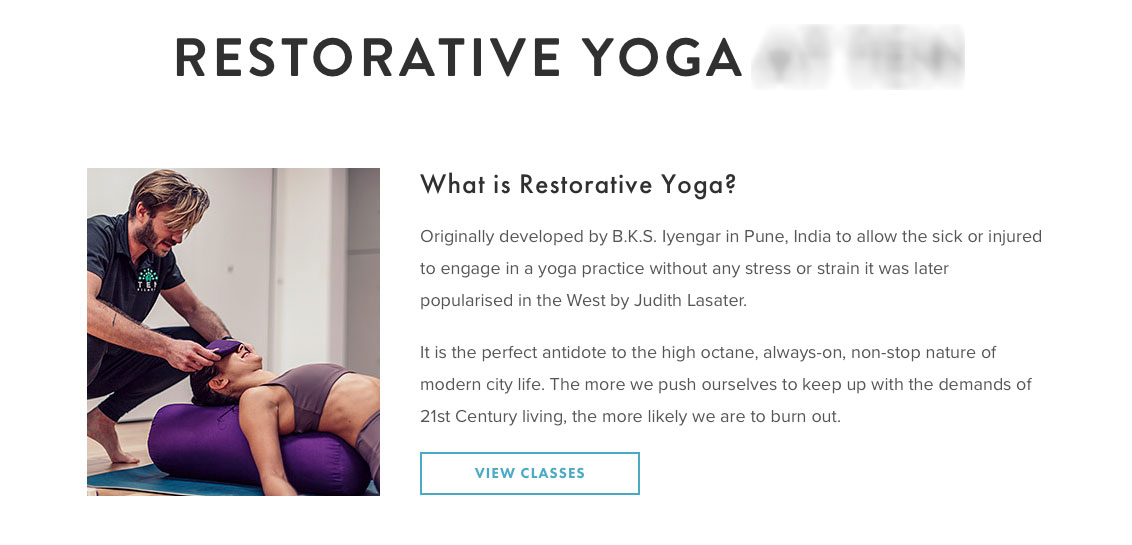
It ranks below position 100 for “yoga near me London”, despite operating in London.
Notice how the main text doesn’t include “London” or any terms related to “yoga classes near me”. Also how it doesn’t include any related search terms. The fact it hasn’t included these terms could be why it performs so poorly for our chosen keyword.
You could simply guess which keywords to incorporate and add these to your content, but the likelihood of this approach generating any results is pretty slim. It could prevent you from connecting effectively with your audience and waste a lot of your valuable time.
This example goes to show that proper keyword research is critical.
Keyword Research Facts
Let’s look at the stats surrounding the benefits of keyword research.
Figures suggest that if you can get to the top of the search results, you can collect a massive 32.5% of all clicks.
So, from this statistic, we can infer that the top-ranking yoga instructor will be getting approximately one-third of all traffic. That’s nearly double what the second place is getting (17.6%) and more than three times the third-place result (11.4%)!
The top-ranking page for any given keyword also ranks in the top 10 for around 1,000 other relevant keywords.
Again, you can see this in action for our yoga example. The top performer for “yoga classes near me London” also ranks highly for “best yoga classes in London,” “free yoga classes,” and so on.
60% of marketers currently doing keyword research report that keyword-rich blog content is their primary source of leads.
This is a great stat that shows the actual results that good keyword research brings to businesses.
53% of customer search journeys begin with typing keywords into Google.
So going back to our example, we might predict that around half of all yoga instructors’ leads come from search engine queries. This is a LOT! If you’re not already utilising a good keyword research strategy, you have the opportunity to increase your leads by over 50%!
Figures suggest that 15% of keywords have never been searched before.
Keyword research is also important for uncovering new keywords – hidden gems that could catapult you to the top of SERPs (search engine results pages). If you can find them, you can target them and gain a first-mover advantage.
What Makes A Good Keyword?
So, now you should have a pretty good idea of what keywords are and why they are important.
What you really need to know before you can delve in, is which keywords to choose when conducting keyword research that will propel you to the top of search results.
We’re going to take you through how to analyze your list of refined keywords, but first, we need to chat about what makes a good keyword.
There are 3 factors to consider:
1. Relevance
This is a simple way of referring to the user search intent. Your chosen keywords from your keyword research need to serve a purpose by offering relevant information to your target audience.
If your content is the best at meeting the user’s needs, it’ll rank #1 for that search query.
2. Authority
You need to prove to Google that you are an authority for your chosen subject or niche. Creating helpful, detailed, and in-depth content that appears all over your website will do this.
However, you need to be realistic when analyzing your keywords. If there is a sea of very popular sites such as Forbes or Business Insider that you know you can’t compete with, it may be worth choosing a more niche topic.
3. Search Volume
Search volume is possibly the most obvious of elements that make a good keyword to target. You want to make sure that people are actually searching for it.
Now this is where it gets interesting because targeting a generic keyword with a large search volume is great if it’s realistic to be able to rank for it (see above).
However, you can generate good levels of traffic by targeting a variety of smaller search volume long tail keywords.
The traffic driven from 5 of these keywords may equate to the same volume of traffic you’d receive from ranking at the top of the search results for 1 high search volume generic keyword.
We’ll discuss how to find the long-tail keyword gems a little later in the article.
Researching Keywords
Real value comes from knowing how to search for keywords and deploy them in a way that increases the likelihood of sales.
We’ve said it before, and we’ll say it again: you need to understand your audience – the type of people searching for your products and services.
Once you know your prospects inside out, you can really get under their skin and align your keyword strategy with the actual phrases they are using. This is how to do keyword research for SEO.
A yoga instructor for busy professionals, for instance, could target common phrases, such as “yoga classes,” to drum up a bit of traffic. And they’d probably have some success.
However, a better approach would be to choose keywords to better suit the intent of the target market. “Weekend yoga classes” or “flexible yoga instructor,” for example, are precisely the type of phrases people with limited time might use.
With this in mind, the next section of this keyword research guide explains how to do keyword research in detail.
Seed Keywords
The first thing you need to do is generate a list of keyword ideas by creating a list of generic topics and keywords that you’ll use as a basis from which to begin your keyword research.
Answer this: which topics do you want to rank for?
These topics are known as seed keywords or pillar keywords and are the cornerstone of the keyword research process. They are like a starting point from which you can derive additional keyword ideas relevant to your offering.
Seed keywords aren’t necessarily the keywords that you should target on your website. This is because seed keywords often have a high ranking difficulty and may be too broad to encourage conversions. We go into more detail on this through the guide.
For now, we’ll start with finding your seed keywords.
How To Find Seed Keywords
There are potentially millions of keywords out there you could choose.
Start by brainstorming thematic words and phrases related to your enterprise. Ideas should revolve around your goals and could include anything related to your company, services, content, blog or anything else you’re trying to promote.
A yoga instructor for busy, stressed professionals, for instance, might start with the following seed keywords:
- Yoga
- Yoga classes
- Yoga instructor
- Online yoga trainer
You can then plug these into keyword generator tools to generate more seed keywords.
Here’s an example of how a top seed keyword will generate additional topics. We’ve entered ‘Yoga Instructor’ into Google Ads Keyword Planner:
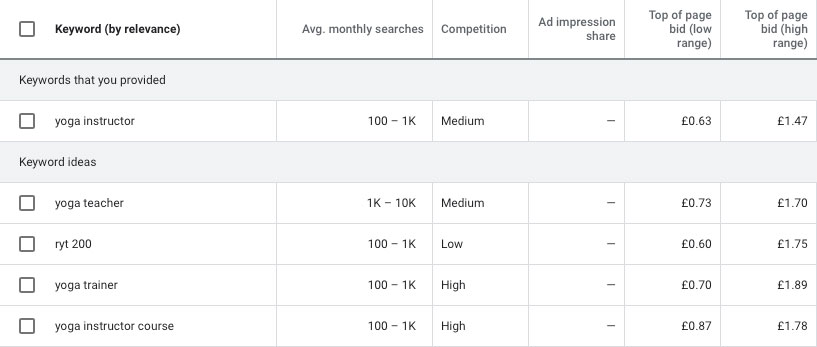
Here’s another example using the paid keyword research tool we use called Ahrefs:

Let’s take another example. Suppose you run a digital marketing agency, and you want to base seed keywords around your services.
In this case, seed keywords might include:
- SEO
- Search engine optimization
- Link building
- Blogging services
At this stage, the idea is to focus on general topics as opposed to worrying too much about specific keywords and search intent. We’re simply drawing the starting line.
Finding More Keywords
After brainstorming a list of seed keywords, you’ll need to expand your list even further using your seed keywords as a starting point.
If you’re struggling to brainstorm, you can use a keyword planner or keyword generator tool. Keyword research tools are integral to our guide on how to do keyword research and competitor analysis.
Google Keyword Planner is helpful because it provides additional links and ideas related to your initial term. So, for instance, if you type “yoga”, Google will offer you a range of clickable searches you can make related to the original keyword, as shown here:
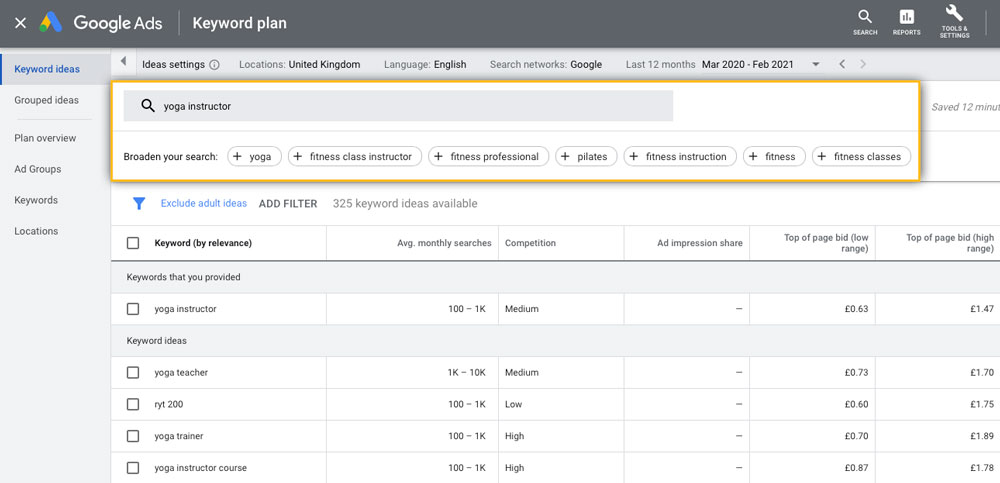
Of course, if you want even more examples of keywords to target, we’d highly recommend Ahrefs.
You can even pinch keywords from Google’s suggested search, as in:
Or you can use questions in the “People Also Ask” section of the results page as keywords in themselves.

For even more FREE keyword research tools, check out our guide to the The 41 Best Free SEO Tools For Just About EVERY Purpose.
Refining Your Keywords
The next step in the process is to choose the keywords you’re going to target.
You need to figure out which of your keywords your audience is likely using when looking for your products and services. This is also known as ‘understanding the user search intent’.
Let’s go back to our yoga instructor business example.
When looking at your long list of keywords related to a seed keyword, it’s likely that that’ll result in a list containing two types of keywords:
- Those that are related to those particular services
- And those that do not
So, for the yoga business, keywords that indicate that users want yoga classes might include:
- Yoga near me
- Yoga for beginners
- Yoga for kids
- Yoga class
- Bikram yoga near me
These are the keywords that the yoga business will want to target.
Keywords related to the seed keyword that do not indicate any intention to buy yoga classes include:
- International yoga day
- Yoga mat
- Yoga facts
The yoga business might want to begin its SEO strategy by avoiding these keywords because those searches, although relevant to yoga, aren’t related to the services of this particular business.
You can apply this technique to your business when you do keyword research, no matter what you sell. Just split the brainstormed keyword suggestions into two categories:
- The searches that people explicitly use to find products and services like yours
- Those who obviously are not users looking to buy
Sometimes, you’ll find keywords that may or may not indicate intent to buy from you. If necessary, keep these in a separate category to potentially explore at a later date.
What Is Search Intent?
User search intent is the goal a user has when typing terms into the search bar.
Understanding user search intent will really skyrocket your keyword research. Not only will it provide you with a sense of direction, but it’ll also make it much quicker.
We’ve already alluded to this concept in our discussion. But it is so critical to the keyword research process that it’s worth talking about it in more detail.
Understanding the overall goal of the user means that you can ensure that you’re creating content that directly answers that query in detail.
Let’s take a look at an example. Say that a user types in “yoga classes”. In this case, most businesses would reasonably assume that they are searching for some kind of yoga instruction, either in person or online.
However, the term “yoga classes near me” is even more explicit. Users typing this into the search bar almost certainly want to go to a class.
By contrast, somebody typing in “yoga mat” probably isn’t looking for instructor-led sessions. They just want equipment.
Understanding the user search intent enables you to separate the wheat from the chaff, letting you target the keywords users search when they want to buy and avoid the rest.
Types Of Search Queries
Search queries are split into different ‘intent’ categories:
- Navigational
- Informational
- Transactional
- Local
Understanding these in detail allows you to deploy keywords even more effectively.
Navigational Search Intent
Navigational search intent refers to searches that indicate that the customer knows where they want to head; they just need Google to take them there.
These are brand queries. For example, if you’re looking for YouTube, you may simply type it into the search bar, and Google will present you with YouTube.
These kinds of queries are particularly difficult to optimize for, as unless you own that exact domain, you’re going to be outranked by whoever does. The only real way to optimize for your own branded navigational search queries is by building brand awareness.
Informational Search Intent
Users searching with “informational intent” are looking to expand their knowledge. They want to learn more about a particular topic.
Businesses sometimes ignore keywords with this type of intent because they don’t think it will lead to a sale. However, informational searches often kick-start the buying cycle in the first place, increase brand awareness, and get users interested in your products.
Users often indicate information intent by asking “why” questions. So, for instance, a person in the early part of the buying cycle for yoga classes might ask, “Why is yoga good for you?” or “Why does yoga make people healthier?”
This person probably isn’t going to buy yoga classes immediately – they’re still in the “research/information gathering” stage of the buying process.
However, a savvy yoga business would attempt to capture these users by providing helpful content that answers their questions. Answers could take the form of:
- A video blog explaining the health benefits of yoga
- Testimonial content that compiles stories of people who have achieved wellness after going to yoga classes
- Infographic about the benefits that yoga brings to the body and mind
Look for the types of keywords users search for when they’re trying to find out more about products and services like yours. Then provide them with helpful information that answers their questions.
If you provide great content – such as blogs, videos, infographics, tools, guides, and whitepapers – users are more likely to move to the next stage of the buying cycle with your brand at the forefront of their minds.
Transactional Search Intent
Transactional intent keywords indicate that the user is close to the purchase phase of the buying cycle.
Also known as “purchase intent keywords,” this special class of keywords suggests that a user wants to buy from you soon (perhaps even right now).
Users with transactional intent will often use keywords such as “buy,” “order,” “deal,” “purchase,” and “discount.” Sometimes called “buy now” keywords.
Other times, transactional keywords indicate that a person will buy soon. For instance, keywords containing “subscribe,” “sign up,” “download,” “schedule appointment,” or “trial” all indicate an intent to interact with a brand. So in this case, transactional keywords are particularly great for businesses wanting to grow their pool of potential customers or for bloggers looking to grow their online community.
When deploying keywords, make sure that you put them in your page titles, product titles, and body content. Writing a large quantity of quality, product-related content on your product pages is a great way to target transactional keywords. You could also create and optimize an email sign-up page or ebook download page, both of which would open the opportunity to rank for these keywords.
Local Search Intent
Lastly, you will also need to consider whether you should target keywords with “local intent.”
Local keywords indicate that users want to find products and services available nearby. This includes local dentists, lawyers, car dealerships, music venues, gyms and the like.
The search terms will include a local identifier such as:
- Near me
- >Town< or >City<
So if you’re looking for a local yoga class, local searches will look like this:
- Yoga classes near me
- Yoga classes in Illinois
- Yoga classes in Chicago
Since the start of the pandemic, searches that include the phrase “available near me” have increased more than 100%, year on year. The reason for this is pretty clear: in an era where we’re being restricted in travel, people need conveniences that are closer to them.
Given this, you might also want to think about how the restrictions might change the keywords people use when searching for your business, but also whether this is long-term. Take-out food businesses, for example, will greatly benefit from optimizing for local SEO keywords at this time.
We have a detailed how-to guide to optimizing your local business for local SEO! Check it out here.
Delve Deep Into Your Niche
When figuring out how to do keyword research, you need to steep yourself in the community you serve; listen to their feelings, explore the topics that matter to them, and observe their questions.
Getting a sense of what it’s like to actually be your customer is one of the most valuable things that you can do.
So, where do you start?
Well, first of all, you need to understand your niche. In doing so, you open the opportunity to capture the exact audience you’re after and help them to convert.
It’s also becoming easier and easier to find keywords in your industry niche. One method is to simply join Facebook groups related to your niche and see which words or phrases come up. You can just watch, wait, and see how the conversation develops. You could even join in!
You can also hop onto forums like Reddit – a really good place to find obscure topics that might be important to the community. Redditers might bring up the same keywords over and over again – colloquialisms related to your company – which you can then plug into keyword research tools for more ideas.
The terms you find on Reddit are often niche but high volume. What’s more, they tend to be less competitive because other companies often aren’t putting the time into exploring what words the community is using.
Find Long Tail Keywords
In your search for the perfect keyword, you’ll need to consider whether to use long tail keywords or short tail – or a combination of both.
Why target long-tail keywords? Simple: they’re incredibly effective.
Finding lots of good low-volume keywords can prove to be highly lucrative. This strategy lets you cast a wider net and attract customers that rivals aren’t targeting.
Figures show that the average conversion rate for long-tail keywords is a whopping 36%, whereas the top 10% of regular landing pages only convert at a rate of 11%. So, if your business can find the right long-tail keywords, you can potentially improve your sales.
The concept of long-tail keywords has been a part of the digital marketing landscape since internet technology writer Clay Shirky introduced it in 2003.
The term “long tail” doesn’t always relate to the length of the keyword – a common confusion for obvious reasons.
Instead, it refers to the niche keywords or search phrases with a lower search volume.
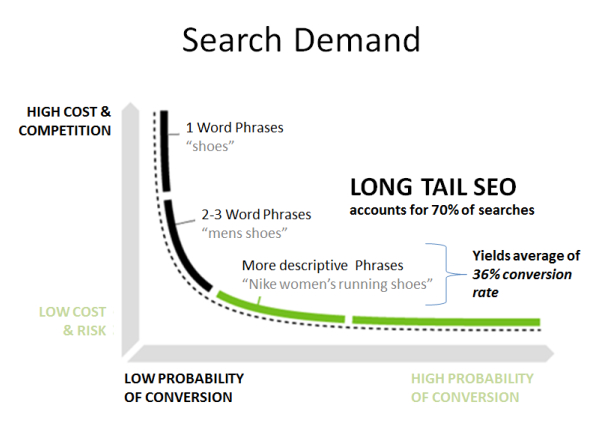
Also, long-tail keywords make up around 70% of all searches on Google and are often easier to rank for.
A long tail keyword is low volume by definition. But, to be a good one – one that you actually want to target – it must also have the following characteristics:
- Be specific to your niche
- Be easy to rank for (low competition)
Here are some examples of long tail keywords for “yoga classes” you could target if you were a yoga instructor:
- Iyengar yoga
- Power yoga
- Yoga for weight loss
- Vinyasa
- Prenatal yoga
- Restorative yoga
- Morning yoga
- Chair yoga
All of these search terms are low volume. But added together, they rival, and even exceed searches for “yoga classes.”
We’ve already mentioned how to find keywords, but here’s a reminder that if you’re still struggling, there are plenty of tools to help you find great long-tail keywords:
- SEMrush: Helpful because it shows you the long-tail keywords your competitors are using. It also displays keyword trends over time, showing you how search volumes are changing; useful for keyword research.
- Google Ads Keyword Planner: Useful because it offers the Discover New Keywords feature discussed above. The keyword generator also lets you filter keywords by region, language, and industry-specific niches. (So, for yoga, you can filter keywords by “style” of yoga automatically).
- Keywords Everywhere: Handy because it’s a browser extension that provides long-tail keywords every time you make a search in Chrome or Safari. Suggestions show up as widgets on the side of the search window.
Analysing Keywords
Once you have a long list of potential keywords, the next step in our how to do keyword research guide is to analyze each one to ensure that they can perform.
How do you carry out a keyword analysis, we hear you ask?
You can use metrics and data to analyze your keywords. By checking the data, you’ll know whether you should be targeting these specific keywords or not.
Here are the six you should focus on first:
1) Keyword Difficulty
Keyword difficulty simply refers to how hard it is to rank for a particular keyword. The higher the keyword difficulty score, the harder you’ll find it to rank for them.
You can check the keyword difficulty manually using free keyword research tools, or quickly by using paid tools.
Checking Keyword Difficulty Manually
To check these manually, we recommend that you use Moz’s free browser toolbar: The MozBar.
Simply download the toolbar and install it on your Chrome browser. Set up a free account, and you’ll be able to analyze any website you visit.
Even better, when you’re in the search results, you’ll see a MozBar of stats beneath each result like so:
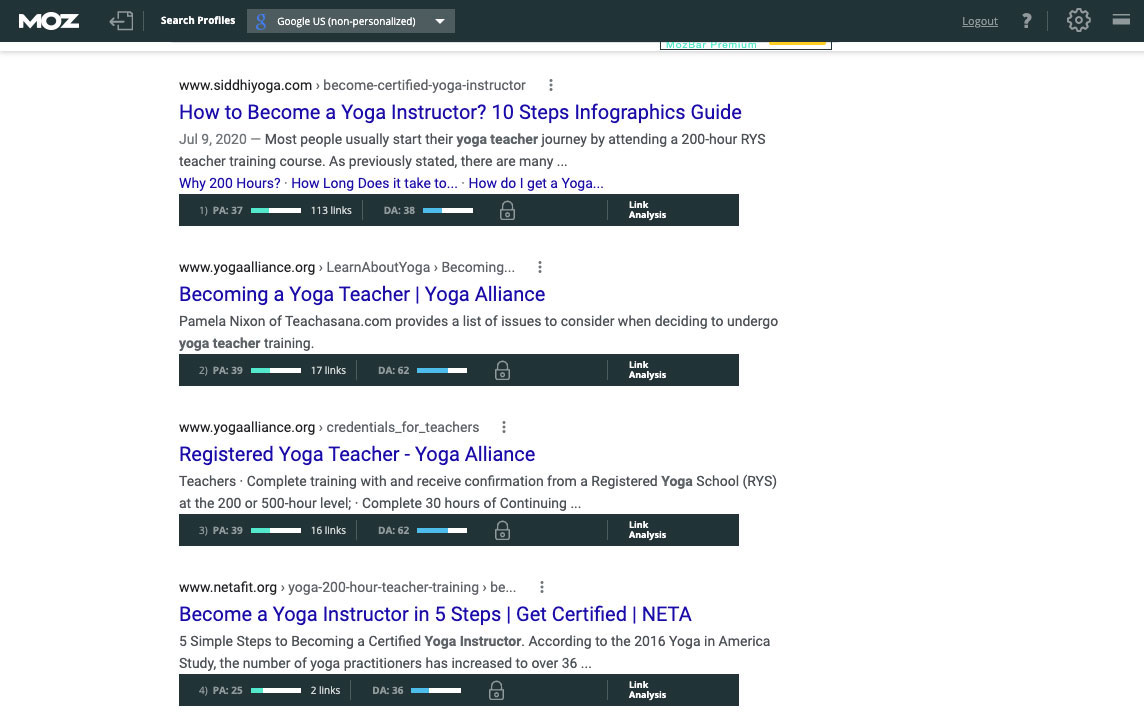
You can analyze the overall search results for that keyword using these metrics:
Page Authority – This is a rating given to the individual page of a website. The higher the score, the better the ranking ability of that page. When looking at the search results, you want this number to be as low as possible. The lower the PA, the more chance you have of nicking its spot in the SERPs.
The number of backlinks – This counts the number of backlinks or ‘votes’ for each ranking page. Backlinks are one of Google’s top ranking factors. The fewer backlinks the ranking results have, the better chance you have of ranking well.
Domain Authority – the final metric you need to consider is Domain Authority. Domain Authority is the number that Moz gives to a whole website to easily indicate its authority. Google likes to rank well-established, high-authority websites well. This metric is important because DA is difficult to quickly increase for your own website. If the search results for your chosen keyword are saturated with high DA websites, you may need to rethink.
Checking Keyword Difficulty Using Paid Tools
If you have access to Ahrefs, we highly suggest this tool for checking keyword difficulty. It accumulates all the factors mentioned above into a keyword difficulty score out of 100.
Head to the Keyword Explorer, enter your keyword, and press the search icon.
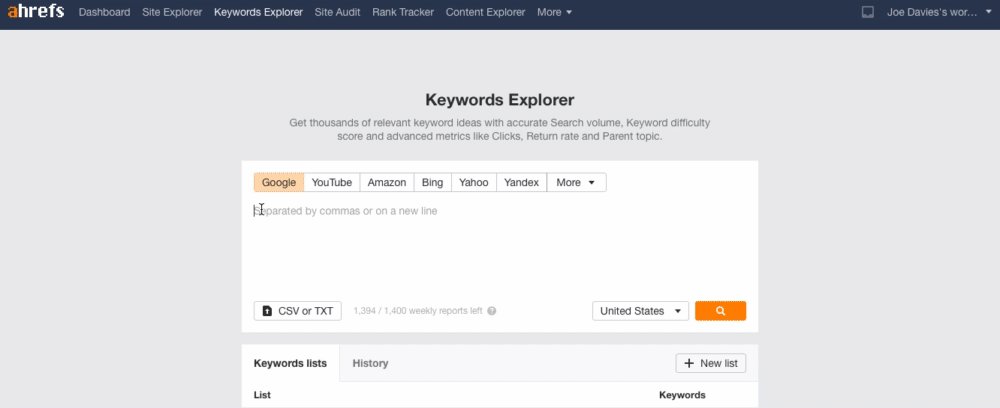
Once loaded, you’ll see a variety of metrics for that particular keyword, the first being the keyword difficulty.
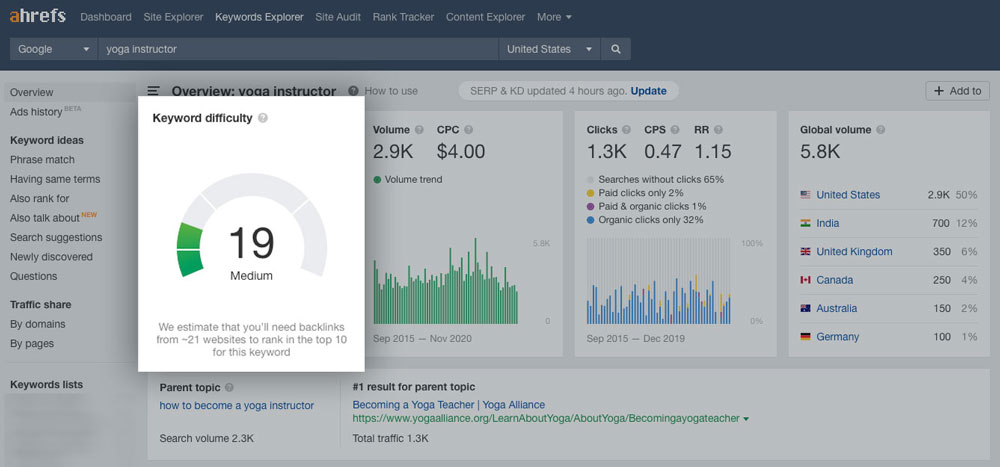
Scroll down to reveal the top results where you’ll be able to check metrics such as backlinks quantities, domain rating and traffic.
2) Search Volume
Search volume tells you how many times people search for a specific keyword in any given month. Search volume is a helpful statistic because it lets you know how many people are using a particular keyword.
The phrase “yoga classes with free pineapple chunks” might be highly relevant to your business. But if nobody is searching for it, then targeting it might not attract many leads. The keyword “yoga classes with meditation” might get many more searchers, implying that it is more relevant to users.
Higher volume keywords usually signal more user interest and are, therefore, usually worth targeting. However, you should note that some high-volume keywords, such as “yoga,” may have such a high keyword difficulty that it would be almost impossible to compete.
Let’s use the tools to test this out.
How To Find The Search Volume For A Keyword
Looking at Ahrefs Keyword Explorer again, we can see that Yoga has an impressive search volume (as expected!) of nearly 200k. However, the keyword difficulty is classed as ‘super hard’ at a score of 92.
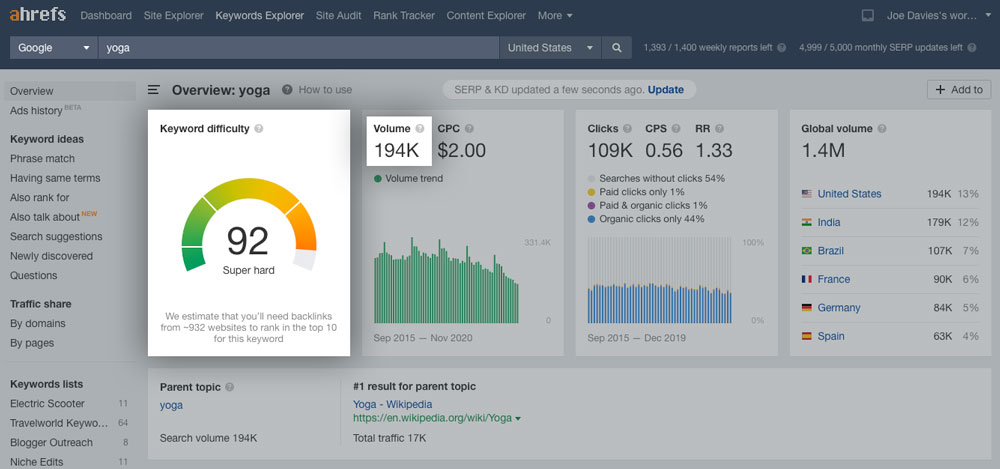
Yoga Instructor has a much lower search volume in comparison, but it’s a more relevant search term to our example business, still has a very good monthly search volume of nearly 3k with a very low difficulty score – win win!

If you don’t have access to a paid tool, you can use Google’s free Keyword Planner. This tool shows you a range indicating the search volumes. We’ve highlighted this in the red box:

10K – 100K means that people enter this search into the Google search bar between 10,000 and 100,000 per month.
However, bear in mind at all times that keyword volumes aren’t an exact science.
So, if you use Google Keyword Planner & cross reference this with Ahrefs, you’ll notice that the volumes are calculated very differently. Although this is the case, you’ll get a good understanding of the differences in search volume nonetheless.
It’s also difficult to monitor keyword search volumes. For example, if user searches decrease, it may change the category from 10K – 100K to 1k – 10K. That could imply a drop between 1 and 90,000 searches per month, depending on the original volume – this is a massive variable and not a particularly useful scale.
Ultimately, analyzing search volumes can support your overall keyword research by filtering out high-volume, highly competitive keywords that don’t serve your overall SEO strategy and relevance to your business.
3) Cost Per Click (CPC)
Cost per click is a metric advertisers use to measure the cost of ads. However, it is also useful when you are trying to assess the value of a keyword. That’s because companies will pay more for ads to sit against the most lucrative keywords.
Check out the following output from Google Ads Keyword Planner for “yoga classes”.

Notice how you pay more for “yoga classes,” even though the search volume for “yoga” is higher.
Why is this? It comes down to relevance. Businesses are competing more fiercely to appear at the top for relevant terms that are more likely to capture users ready to convert.
“Yoga near me” also costs more than just yoga because it too indicates that the user intends to attend a local yoga class.
Ideally, you’d like to find keywords with low CPC but high relevance to your company. However, you need to be careful. Low-competition business-related keywords are rare. Brands have already found many of them. So, if you find a low-cost keyword that seems too good to be true, double-check that it is relevant. It might not be.
“Hot yoga,” for instance, might look like a great keyword for a Bikram yoga business. But people could be searching for it for more information on what it is, without any intention of attending a class themselves.

Notice that the price of a click is low for this keyword. That could indicate a bargain, but it could also indicate that it isn’t commercially relevant.
4) Click Through
Google receives more than 3.5 billion searches per day. But not every user is clicking on websites and visiting pages. Instead, they’re stopping at page results.
Why is this?
Well, this is mostly a result of the increased appearance of SERP features. SERP features often provide the answers search engine users need right there in the results pages, meaning that clicks can be low.
This is good and bad. We’ll get into SERP features shortly, but it’s safe to assume that in order to convert, you need your customers to visit your website.
The best way to establish how many clicks a website is getting for free is by checking Google Keyword Planner.
Head to Keywords in the menu on the left and type in your keyword.

From the results, you’ll be able to see that clicks for Yoga massively outweigh the clicks for Yoga Classes.
Again, this is where you need to weigh up all the other metrics. Is it worth your resources to compete for a keyword with such a high difficulty to try and capture these clicks?
Let me draw your attention to the Click Through Rate. The CTR for Yoga Classes is higher, which means you can assume the conversion rate is too…
5) SERP Features
SERP features can also support your keyword research and ensure you’re targeting the right keywords. They’re essentially pockets of information that sit in the search results among the usual list of URLs.
Google adds SERP features primarily to enhance the user experience.
Finding the SERP features that appear in the results for your chosen keywords is simple. You can do this manually or using Ahrefs.
To do this manually, simply type the keyword into Google:

You’ll see from this search for Yoga Classes that you scroll through Ads, Local snack pack results, People Also Ask, and YouTube Videos before you get to the organic search results.
From this list, you would analyze the results and work on incorporating this content (but even better!) whilst including the same keywords.
For an even quicker way to scrape the SERPs, we use Ahrefs, so let’s pop back onto the Keyword Explorer.

You can also make use of another SERP feature called “rich snippets.” A rich snippet is like a fleshed-out version of a regular organic search snippet, providing more information.

This is a rich snippet because it provides additional details you wouldn’t ordinarily get from bog standard Google results, such as whether the venue is open, it’s star rating, directions to get there, and so on.
Targeting rich snippets is a great way to increase your site’s visibility because they appear at the top of search results and provide users with extra utility. You can also better target keywords such as ‘reviews’, ‘opening times’, ‘directions’ and more.
However, alongside all other SERP Features, click-through rates for rich snippets tend to be relatively low.
6) SERP Results
Lastly, the SERP results are not technically a metric, but you’ll want to check on the actual websites and web pages that appear in SERP results for your target keywords. This process shows you which competitors are ranking highly for your targeted keywords and why.
Your goal should be to identify the way in which they’re applying keywords to get to the top of the search results. From here, you can plug any “gaps” between what they’re doing and what you’re doing.
You can analyze why your competitors rank better than you for specific keywords in two ways. Manually or by using a keyword research tool.
We’ll be using Ahrefs Site Explorer for this. You type your competitor’s URL into a field and then compare their performance across ranking factors compared to yours.
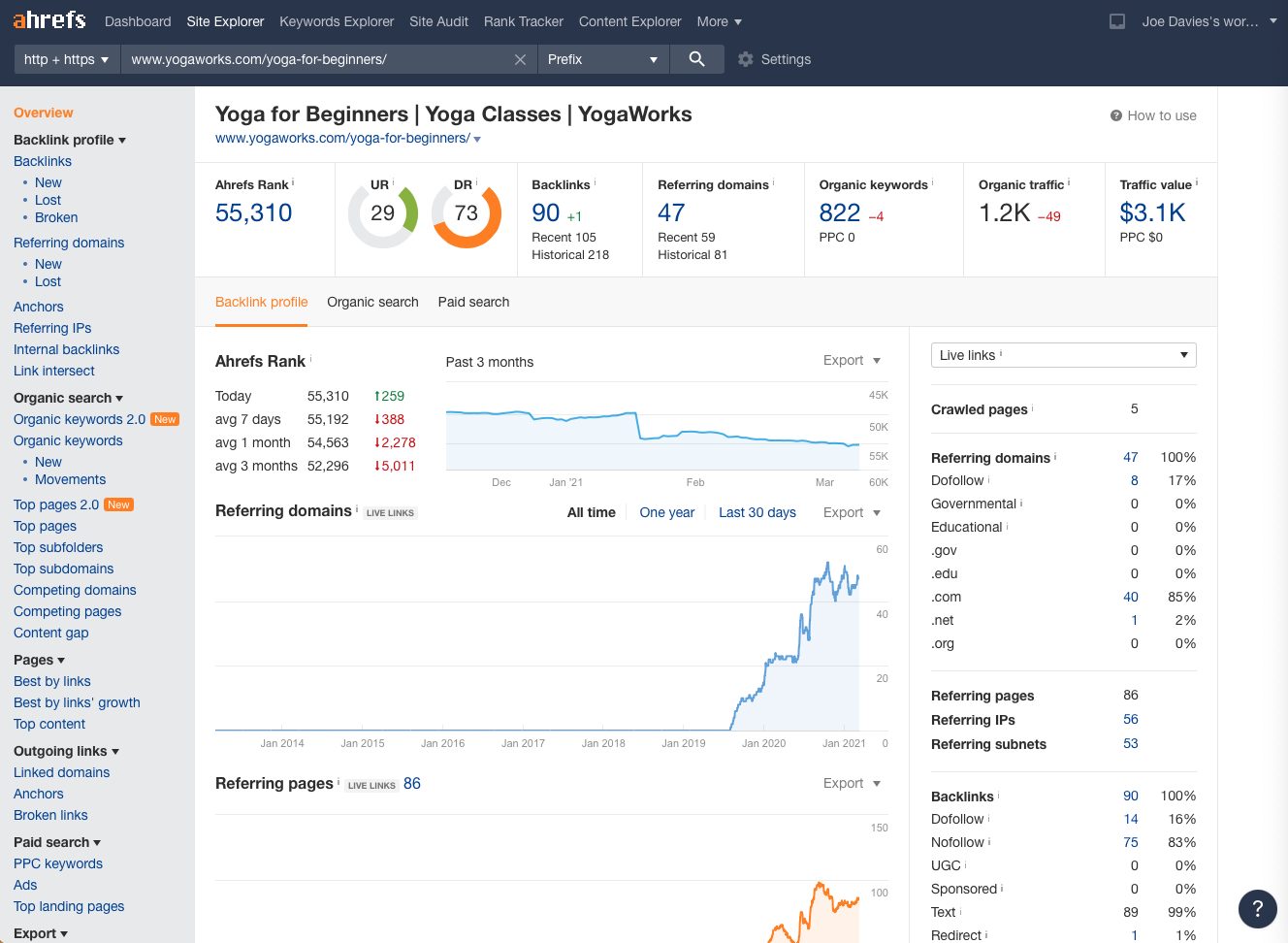
The results show actionable metrics you can use to improve your performance. These include:
- Valuable keywords your rivals use that you don’t yet rank for
- How often do rivals use keywords across their domains compared to you
If you drill down to page-level analysis, you can get an even clearer picture of why your competitors are ranking well.
For instance, you can compare pages for sets of keywords to see which keywords you should be targeting to better compete with similar pages elsewhere.
The idea here is to make keyword research an ongoing process, one in which you’re continually keeping an eye on your rivals to see what they’re doing right (and wrong). By doing this, you can find out what your page isn’t targeting yet, and how it could better optimise. Optimal keywords continually evolve, so you need to regularly review top SERP results to keep up.
To analyze the actual content, you could use another keyword research tool called Surfer SEO.
You can take the content from each webpage and paste it into Surfer SEO’s Content Planner.

It’ll tell you improvements they could make to their content, giving you an understanding of how you can create content that’s bigger and better!
Applying Your Chosen Keywords
The last stage in the cycle is to apply your keywords to your website.
You should go into this process with the intention of applying them everywhere you can whilst making sure that they’re as natural as possible.
Yes, keywords should appear on your blogs and product pages. But they should also be present in:
- FAQ pages
- Home pages
- About pages
- Contact pages
- Product category pages
- PDFs
- Testimonials pages
- Review pages
- Press releases and news pages
- Privacy policy pages
- Sitemap pages
- Careers pages
- Advertisement pages
- Affiliate link pages
Do keyword research for each of these pages by following our process. It’s important to do keyword research for these pages individually because their goals vary.
You can place the keywords in:
- Website body content (regular paragraphs and text snippets)
- Headers, sub-headers, and title tags
- Meta descriptions (the description of a page that sits as a snippet below the page link in SERPs)
- Breadcrumbs (site tools that allow people to pinpoint where they are in your page structure, allowing them to easily navigate back to relevant sections)
- Blog posts
- Downloadable files (such as PDF white papers)
Be careful not to “stuff” keywords too densely.
Google may punish websites it suspects of inserting too many keywords. According to industry experts, target keywords should appear once or twice per 100 keywords.
The text should still read naturally and add value to users, but adding the keywords will ensure that your content stays on theme & is easily read by Google’s spiders.
Final Thoughts On How To Do Keyword Research
By now, you should have a much better understanding of why keyword research is so important. You need it to rank for keywords your audience is actually searching for.
In this keyword research guide, we learned how to search for keywords, how to find keywords your competitors are using, and where to put them on your website.
We also provided you with some SEO training, showing you how to do keyword research to rank higher in search results.
Ultimately, the goal of keyword research is to drive conversions and support your business’s success.
By understanding and implementing the recommendations in this guide, you should see a change in the amount and quality of traffic arriving at your pages.
If you’re looking for help to find the keywords your customers are searching for, why not check out our keyword research service? We can quickly report on hundreds of thousands of keywords on your behalf, giving you time to focus your efforts elsewhere. We’ll also give you an indication of the search intent for each keyword in addition to providing you with recommended actions to help you prioritize search terms for the quickest results.
Whether you opt to conduct your own keyword research or you try out our service, we hope you now feel armed with everything you need to make the best-informed decisions for your campaigns.
Best of luck out there!
Become a Pro at SEO
Join 65,000 others and learn the secrets to SEO success with our weekly blog posts.

